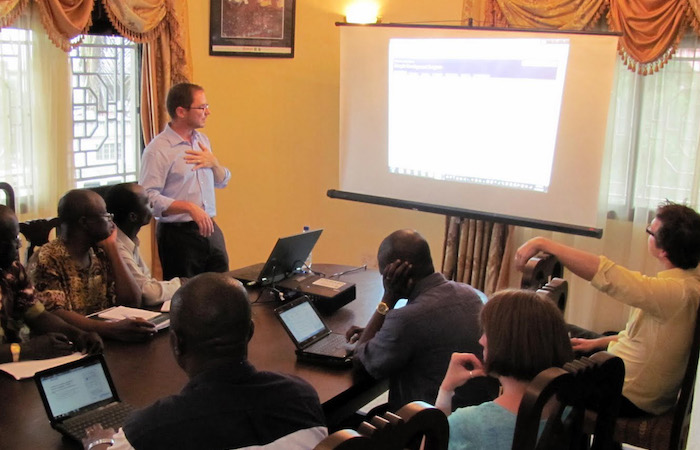Listen Now
How do you go about monitoring and tracking the work that you’ve accomplished as an implementer of humanitarian aid or development assistance? This question has been answered 1000s of times by 100s of organizations around the world. Even though we’re in the year 2016, the reality of tracking progress for the vast majority of initiatives out there is one of two things: written reports in Microsoft Word or numbers on an Excel spreadsheet…. that then get translated into a narrative report in Word. I’m not kidding. I’ve been evaluating programming in this world for more than 10 years and I have yet to be hired for an assignment where, as a first step, my client sends me a username and password for their online information management that has the ability to instantly report on total program progress with a complete package of visualization and analytical tools. This isn’t to say this doesn’t exist: in fact, when I first cut my teeth in development with a large NGO back in the early 2000s, they already had built an internal, web based monitoring system. And I’ve seen a bunch of flavors of the same type of thing in organizations around the globe. For some reason, even though there have been countless attempts at making this process better, at the project level, we still revert back to spreadsheets and reports. Herb Caudill is on a mission to change all of that. As my guest today for the 104th episode of Terms of Reference, the founder of DevResults thinks we might finally be at a stage where data, connectivity and capacity are all at levels that real time project analysis and management is possible. Herb loves to make elegant and efficient systems that solve real-world problems. He is a data-visualization geek, a graphic designer, and a programmer, he started out building websites and software for international development organizations, including USAID, the World Bank, GIZ, DFID, the World Resources Institute, and Chemonics International. Herb grew up in Latin America and worked in Africa for 5 years, first teaching high-school math with the Peace Corps and then working on internet connectivity initiatives with USAID. Today, DevResults is used to manage more than $3 Billion worth of foreign assistance. You can connect with Herb here: https://twitter.com/herbcaudill http://stackoverflow.com/users/239663/herb-caudill
IN TOR 104 YOU’LL LEARN ABOUT:
- About project management, reporting and data visualization software, the most important innovation you did not know you needed.
- How the development field is using reporting tools and procedures that “a small chain of convenience stores would deem unacceptable.”
- About DevResults and what the subset of development developers have accomplished on web reporting standards and increasing, albeit still limited, adoption of those.
- The data complexities of a global development ecosystem; how nobody has got it together when it comes to streamlining data reporting and formatting.
OUR CONVERSATION INCLUDES THE FOLLOWING:
Organizations
- DevResults http://devresults.com
- USAID
- Extractive Industries Transparency Initiative (EITI)
- World Bank
- MS Office
- Global Transparency Initiative
Topics
- Project Management Software
- Automated Reporting Tool
- Reporting Standards
- Data Visualization, Data Science
- Sofware as a Service (Saas)
- Extensive Markup Language (XML)
- Transparency, Open Data
- Complexity
Places
- Barcelona
EPISODE CRIB NOTES
DevResults: Tracking progress for development assistance Web based application for international development project management (Saas). 4 years. USAID workers and contractors, Europe, World Bank. There is a common set of challenges organizations face: What the outcomes of the project are. In other words, how data is reported to managers and funders. Reporting and visualizing aid First thing DR does is streamline, both data and money. There is quarterly or semiannual reporting. Common tools (Office, PDFs) is inadequate. DR wants to avoid shelved reporting. 5 NGOs are working on a vaccination project. They all should be able to report the same data under the same standards, so data is comparable. “In the current model this simply does not happen.“ Reporting needs to be pre-formatted and streamlined, so it’s just a matter of entering the data and submitting it. Current solutions require a lot of hours put into standardizing data. The ecosystem DR is an open markup solution. “We cannot force an entire ecosystem to use DR,” but DR needs to be able to communicate with its many markups. DR embraces open standards. DR adoption has been mostly due to reporting requirements from users. There is a tension between reporting and business intelligence or “situational awareness.“ DR is not yet widespread as an intelligence tool. Priorities changing because of DR and DR-like solutions The success stories go as follows: “it used to be a pain… and now it’s not.“ The next wave of challenges involve transparency and the Global Transparency Initiative. Another is about moving beyond reporting just financial information and include specific project metrics. Often times large organizations, being the only one with resources, fund surveys to assess the real impact of the interventions, aside from the funds to the project themselves. A data solution could avoid the redundancy. Organizations cannot always keep track of flow of funds. Comparative analyses seem to be out of the question. The data and organizational complexity “begs for software.“ There seems to be little to no incentives to automate reporting. “Better information is not going to make you more money. It’s not business.“ Taxpayers are also not vocal about efficacious spending. Competition and the next five years More and more organizational embrace, in detriment of Word and Excel. Herb thinks there will be more reporting systems built from scratch, but “as the #2 player, there should not be.” It’s the “reinvention of a wheel.“ However, there has been more and more calls for “parametrization” of a system for an organization’s specific needs, as opposed to “building.” USAID is aware of DR and DR-like systems. It used to be heartbreaking for Herb (and Stephen) that projects implemented a reporting tool that would be shelved as long as the project ended. Countries have come forward embracing transparency. Shout out to EITI for providing markup (XML) standards and promoting open data availability. Automated systems in a not-so-quick-to-react world Common data standards “are not rocket science.“ Herb does not really see a generation gap. “It’s frustrating for everyone, across ages and levels.“ People should be able to “look and know.” Everyone would like to do that. We all should be able to quickly answer how U.S. funds have been spent in a given year. It’s 2016, we should be able to answer those questions. International examples and innovation There are no examples that Herb would consider exemplary. “Not even the Scandinavians.“ Everybody is under the impression that everyone else is doing it and better so. “But we have worked with enough organizations to be able to say confidently: nobody has their shit together on this. Nobody.“ Herb started as a solo developer. On the ground, he received feedback and customization requests. Once a critical mass was acquired he could not took care of feedback alone, so developers jumped on board, along with data scientists. His team decides on what their “next big thing” is going to be, which is difficult enough. Innovation workflow An advantage of Saas is the ease of pushing updates to everybody. Layout changes are not always welcome, but they are done for the benefit of the majority. Organizations can customize and turn modules off, so sometimes they don’t see improvements. On watch “This is a very particular space. Nothing from the real world applies here.“ The sticky question is always: how to do it better? Herb & Co. often face problems and questions nobody has before, along with some very common ones (mostly about spending money). So the strategy is about balancing a focus on their specific subject and at once looking out for how the other players are sorting out the more general questions. Plugs Live data feeds available to managers “is going to rock the development world.“ Data flows in their right format “will be a very dramatic innovation.“Please share, participate and leave feedback below!
If you have any feedback you’d like to share for me or Herb, please leave your thoughts in the comment section below! I read all of them and will definitely take part in the conversation. If you have any questions you’d like to ask me directly, head on over to the Ask Stephen section. Don’t be shy! Every question is important and I answer every single one. And, if you truly enjoyed this episode and want to make sure others know about it, please share it now:[feather_share show=”facebook, twitter, linkedin, google_plus” hide=”reddit, pinterest, tumblr, mail”]
Also, ratings and reviews on iTunes are very helpful. Please take a moment to leave an honest review for The TOR Podcast!




